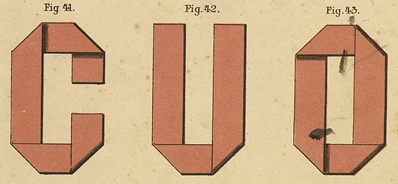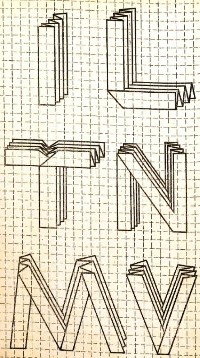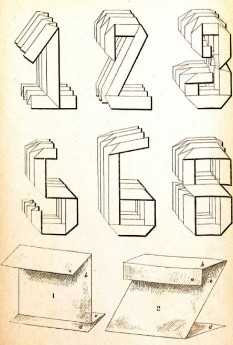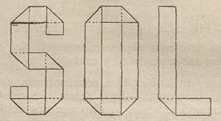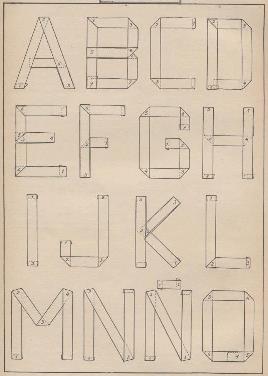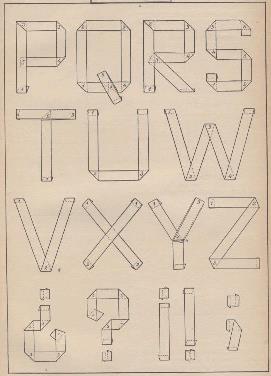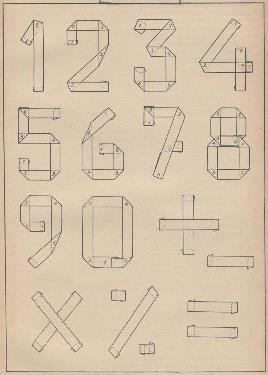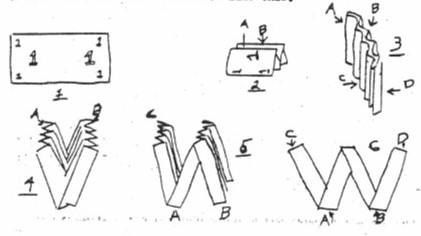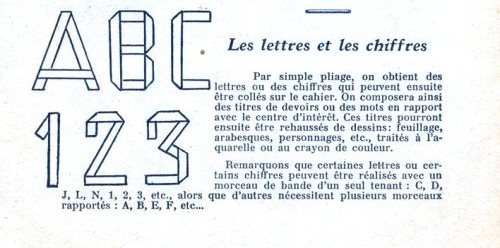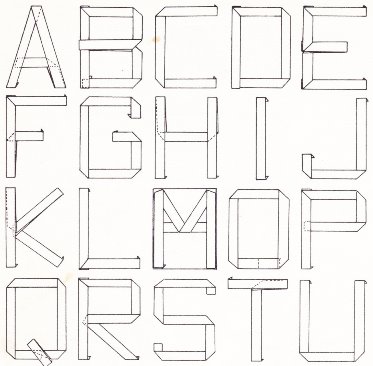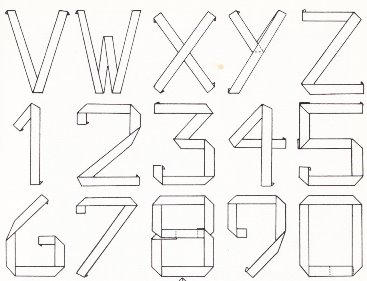| The Public Paperfolding History Project
Last updated 29/2/2024 x |
|||||||
| Paper Alphabets, Letters and Numbers | |||||||
| This
page is being used to collect information about the
history of Paper Alphabets, Letters and Numbers. Please
contact me if you know any of this information is
incorrect or if you have any other information that
should be added. Thank you. ********** 1863 The first Paper Alphabet that I am aware of appears in 'De Kleine Papierwerkers 1: Wat men van een stukje papier al maken kan: Het vouwen' (The Small Paperwork 1: What one can make from a piece of paper: Folding) by Elise Van Calcar, which was published by K H Schadd in Amsterdam in 1863. The letter Q is not included.
********** 1887 Instructions for folding a small number of letters from paper strips appear in 'Cours de Travail Manuel (Pour les Garcons) - Premiere Partie - Cours Elementaire' by A Planty, which was published by Gedalge Jeune in Paris in 1887.
********** 1889 Instructions for folding a small number of pleated letters and numbers appear in 'Jeux et Travaux Enfantins - Premičre partie: Le Monde en Papier' by Marie Koenig and Albert Durand was published by Librairie Classique A. Jeande in Paris in 1889.
********** 1891 There are references to letters and numbers folded from paper strips in the 'Bulletin de la Societe de Protection des Apprentis', an official document issued by the Societe de Protection des Apprentis et des Enfants Employes par les Manufactures in Paris in 1891 but no illustrations are given. ********** 1892 The name 'Louis' made from letters folded from paper strips appears in 'Le Travail Manuel a L'ecole Primaire' by Jully & Rocheron, which was published by Librairie Classique Eugene Belin in Paris in 1892.
********** 1893 A full alphabet folded from paper strips in a similar way appears in 'L'Annee Preparatoire de Travail Manuel' by M P Martin, which was published by Armand Collin & Cie in Paris in 1893. The letters are K, W and Y are not included.
The same book also includes the numbers 1-9. The O in the alphabet can clearly function as a zero.
********** 1904 Three letters folded from paper strips appear in 'Guia Practica del Trabajo Manual Educativo' by Ezequiel Solana, which was published by Editorial Magisterio Espaņol in Madrid in 1904.
********** 1940 A similar alphabet folded from strips, but which this time also contained punctuation marks and mathematical symbols appeared in 'El Plegado y Cartonaje en la Escuela Primaria' by Antonio M Luchia and Corina Luciani de Luchia, which was published by Editorial Kapelusz in Buenos Aires in 1940.
********** 1945 'Bill Folds' by Al O'Hagan published by George Snyder's Magic Shop of Cleveland, Ohio in 1945. It included diagrams for folding a Double 'U' from a dollar bill.
********** 1951 The extended version of 'El Mundo de Papel' by Dr Nemesio Montero, which was published by G Miranda in Edicions Infancia in Valladolid in 1951, contains instructions for developing 'El Alfabeto en Relieve' (The Pleated Alphabet).
********** 'Occupons Nos Doigts' by Raymond Richard, which was published by Les Editions des CEP in Villefranche in 1951, contains brief instructions for foding letters and munbers frpm strips.
********** 1958 Volume 1, Issue 3 of 'The Origamian', which was published in December 1958 contains information about the money folding practised by the magician Victor Frenkl:
********** 1960 Some 'Paper Letters and Numerals' appear in 'Paper Folding Fun' by Robert Harbin, which was published by Oldbourne in London in 1960.
********** 1965 Folded letters that form the word 'Origami' are embossed on the outside of the front board of 'The World of Origami' by Isao Honda, which was published in the USA by Japan Publications Trading Company in 1965.
********** |
|||||||

